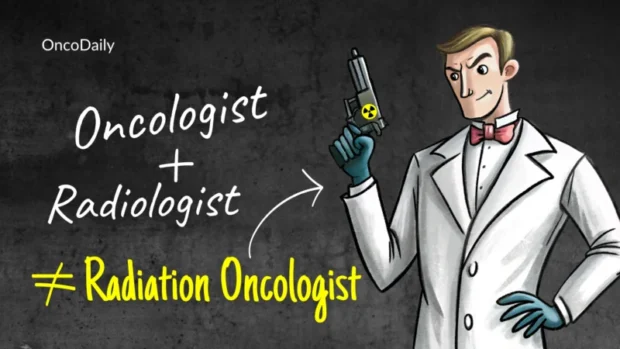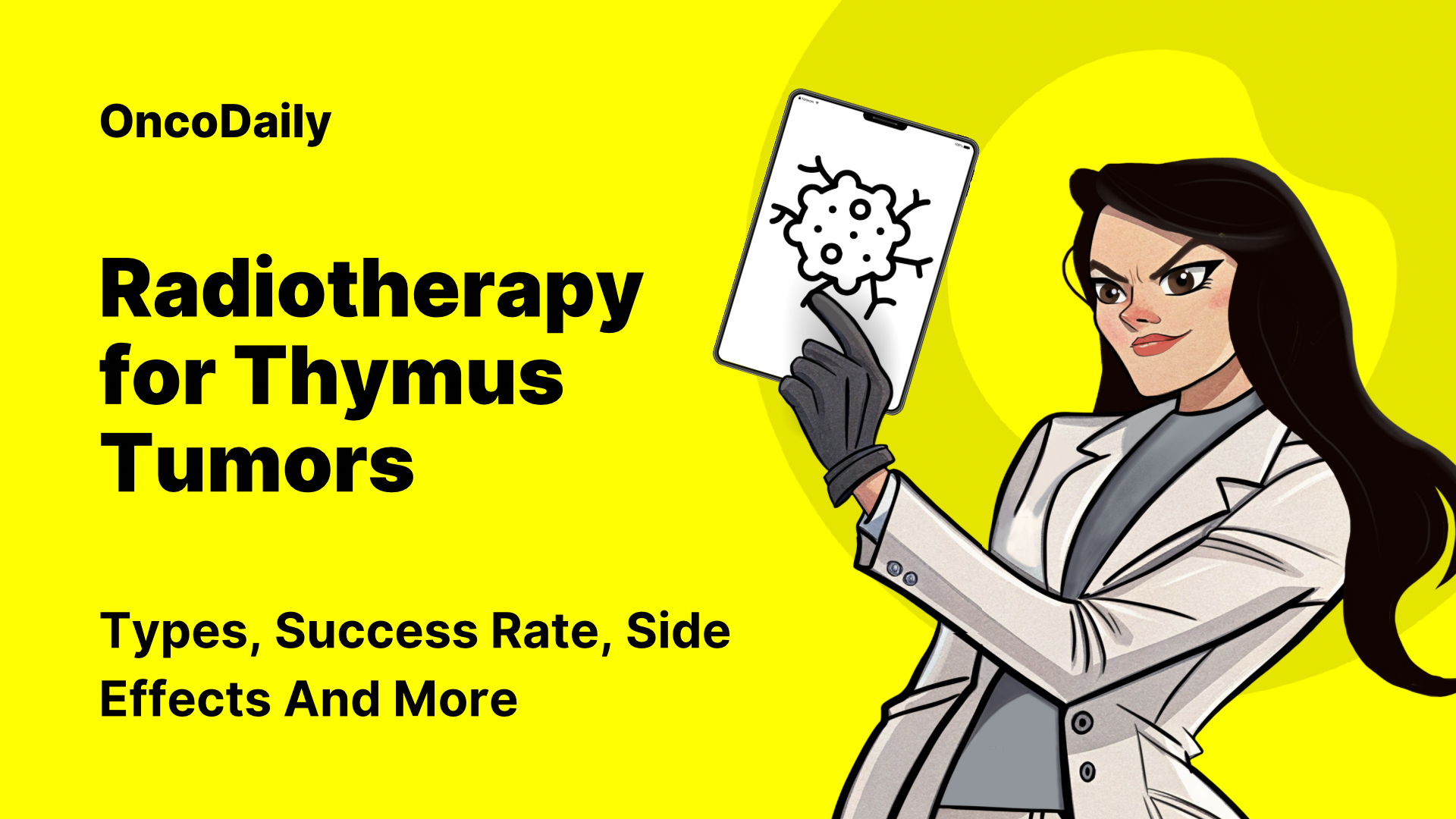Radiotherapy for thymus tumors plays an important role in both curative and palliative care. Thymomas and thymic carcinomas, although the most common primary tumors of the anterior mediastinum, are still rare and can range in behavior from indolent to highly aggressive. While surgery remains the cornerstone of treatment, radiation may be given after surgery to lower the risk of recurrence, as the main therapy for unresectable tumors, or together with chemotherapy in more advanced disease.
When Is Radiotherapy for Thymus Tumors Used?
Radiation therapy for thymic tumors can be used in several different clinical settings, depending on stage, tumor histology, and the possibility of surgery. After surgery, it is often recommended for patients with stage II or III thymomas or thymic carcinomas, particularly if there are close or positive margins, while it is generally not required for completely resected stage I thymomas.
When microscopic or gross disease remains after surgery, radiation should begin within three months, often at higher doses, and may be combined with chemotherapy in thymic carcinoma. In cases where tumors are initially unresectable, induction therapy with chemotherapy, radiation, or both may be given to shrink the disease and make surgery possible. For patients who cannot undergo surgery at all, radiation becomes the main local treatment, usually delivered with chemotherapy to increase effectiveness. In advanced stages, it can also be used in a palliative setting to relieve symptoms such as chest pain, cough, bleeding, or swallowing difficulties.
How Is Radiation Delivered?
he standard approach is external beam radiation therapy (EBRT), where high-energy beams are directed at the tumor from outside the body. Modern conformal techniques allow more precise targeting and sparing of nearby organs:
- 3D conformal RT (3D-CRT) and IMRT (intensity-modulated RT) shape beams around the tumor and adjust their strength.
- Proton therapy can reduce radiation to the heart, lungs, and spinal cord, especially important since thymic tumors sit in the middle of the chest.
- Image-guided RT (IGRT) and 4D motion management improve accuracy by accounting for breathing and tumor movement.
- Stereotactic radiosurgery (SRS/SBRT) delivers very high, focused doses in one or a few sessions, typically for small or recurrent lesions.
- Brachytherapy may be used in select cases, with radioactive sources placed inside or near the tumor.
Before treatment, patients undergo CT-based planning scans to determine the exact area to target. Sessions are painless, each lasting a few minutes, though positioning and imaging can take longer. Treatment is usually given five days a week for several weeks.
Side Effects of Radiotherapy for Thymus Tumors
Radiation therapy is an important component in the management of thymomas and thymic carcinomas, but because these tumors are located in the mediastinum, close to critical organs such as the heart, lungs, esophagus, and spinal cord, side effects can occur. Modern techniques like IMRT and proton therapy have greatly improved precision and reduced risks, but both temporary and long-lasting effects are still possible. The type and severity of side effects depend on the total radiation dose, whether chemotherapy is given at the same time, and the patient’s overall health.
Short-Term Side Effects
Short-term effects usually develop during treatment or within a few weeks after it ends. Common issues include fatigue, skin redness or irritation in the treated area, nausea, poor appetite, and weight loss. Radiation to the chest often irritates the esophagus, leading to painful swallowing and difficulty eating. Some patients may also experience vomiting, cough, or shortness of breath. If the abdomen is included in the field, diarrhea can occur. Radiation can temporarily suppress bone marrow, which lowers blood counts and may cause anemia, weakness, or an increased risk of infections. Most of these effects improve gradually after treatment is completed, and supportive care such as dietary changes, medications, and rest can help manage them.
Long-Term Side Effects
Late effects may appear months or even years after treatment and are more serious because they can be permanent. Radiation to the chest can cause scarring in the lungs, leading to chronic breathing difficulties, or long-term inflammation of the esophagus. The heart is also at risk: mediastinal radiation has been linked to pericarditis, coronary artery disease, and other cardiac complications. Damage to large blood vessels in the chest may occur in rare cases. Because thymic tumors often affect younger or middle-aged adults who may live for decades after treatment, long-term toxicities are a particular concern. This is why careful planning, advanced radiation delivery techniques, and close follow-up are essential to reduce risks and detect problems early.

Read OncoDaily’s Special Article About Radiations Oncologists
How Long Does It Take to See Results After Radiotherapy for Thymus Tumors?
For patients receiving postoperative radiotherapy, the main benefit is seen over the long term, typically measured in years, as it lowers the risk of local recurrence. In patients with unresectable thymic tumors treated definitively, the response is usually assessed with imaging studies such as CT or MRI about 6 to 12 weeks after treatment, and then at regular intervals during follow-up. When radiotherapy is given with palliative intent, symptom relief—such as easing chest pain, cough, or difficulty breathing—can often begin within one to two weeks, though some patients may notice improvement in just a few days, while in others it may take up to a month.
Number of Sessions
The total course varies with intent. Adjuvant or definitive treatments usually require daily sessions over five to six weeks (around 25–30 treatments). Palliative courses may be shorter, sometimes one to two weeks, and stereotactic treatments can be completed in just a few sessions.
Taking Care of Yourself During Radiotherapy for Thymus Tumors
Radiotherapy for thymus tumors can be tiring and sometimes causes side effects like sore throat, trouble swallowing, cough, or skin irritation. Looking after yourself during treatment can make it easier and help you feel stronger.
Eating and Drinking Well
Try to eat small meals often, especially foods that are soft and easy to swallow, like soups, smoothies, or yogurt. Choose high-protein foods such as eggs, fish, or beans to keep your strength up. Drink plenty of water throughout the day. If eating becomes difficult, ask your care team for tips or a referral to a dietitian.
Caring for Your Skin and Throat
The skin in the treated area may become red or itchy. Use gentle, fragrance-free soap and moisturizer, and wear soft, loose clothes to avoid rubbing. If swallowing is painful, your doctor can give you medicines to make eating easier.
Staying Active and Resting
Light activity, like short walks or stretching, can help fight fatigue and keep your lungs working well. Don’t push yourself too hard—rest when you need to. Breathing exercises can also help if you feel short of breath.
Talking to Your Care Team
Always tell your doctors and nurses if you notice new problems, such as pain, cough, or trouble swallowing. They can give you medicines or other treatments to make you more comfortable. Never hesitate to ask questions or share concerns.
Looking After Your Emotions
Treatment can be stressful, but you don’t have to go through it alone. Talking with family, friends, or a support group can help. Relaxation techniques such as meditation, listening to music, or gentle exercise can also reduce anxiety.
Written By Aren Karapetyan, MD
FAQ
What is radiotherapy for thymus tumors?
It’s a treatment that uses high-energy X-rays or particles to kill cancer cells in the thymus gland.
When is radiotherapy used?
It may be given after surgery to lower the risk of recurrence, as the main treatment if surgery isn’t possible, or together with chemotherapy in advanced cases.
Can radiotherapy cure thymus tumors?
It can control or sometimes cure the disease, especially when combined with surgery. In advanced cases, it often helps relieve symptoms.
How is the treatment given?
A machine outside the body directs radiation beams at the tumor. Treatments are painless and last only a few minutes, but you’ll usually come 5 days a week for several weeks.
What modern techniques are used?
Doctors may use IMRT, proton therapy, or image-guided therapy to target the tumor more precisely and protect the heart, lungs, and esophagus.
What side effects can happen during treatment?
Tiredness, skin redness, sore throat, painful swallowing, cough, or nausea are common. These usually improve after treatment ends.
Are there long-term side effects?
Sometimes radiation can cause lung scarring or heart problems years later. Newer techniques greatly reduce these risks.
How soon will I feel results?
If given after surgery, the benefit is long-term in lowering recurrence. For symptom relief, improvements like easier breathing or less chest pain may appear within 1–2 weeks.
How many sessions will I need?
It depends on the goal: about 25–30 sessions over 5–6 weeks for curative treatment, or fewer sessions if it’s given to ease symptoms.
How can I stay healthy during treatment?
Eat soft, nutritious meals, drink plenty of fluids, rest when tired, stay lightly active, care for your skin, and tell your care team about any new problems.
